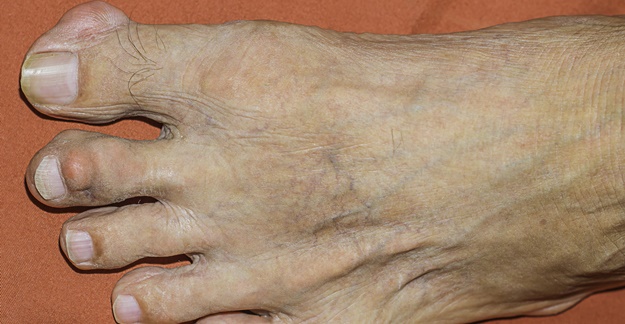Gout has a name-recognition problem.
Even though its prevalence is increasing dramatically in the US, many physicians don’t recognize how serious the condition can be, says N. Lawrence Edwards, MD, a rheumatologist with University of Florida Health in Gainesville and chairman of the Gout & Uric Acid Education Society. (Editor’s note: The society receives funding from pharmaceutical companies.)
“We know more about gout’s causes and genetics than any other form of the disease, yet it remains one of the most poorly treated forms of arthritis,” Edwards says.
This very painful form of inflammatory arthritis is caused when uric acid crystals accumulate in the joints. It can manifest through sudden, severe pain, redness, tenderness and swelling in the joints, and often starts with the big toe.
About 4% of American adults have gout, about double what it was 30 years ago, Edwards says. It impacts about 8.3 million Americans.
The rate is soaring because of an aging population, and is also impacted by the obesity epidemic, he notes.
Treating Short-Term Gout Attacks
To treat short-term gout attacks, doctors typically prescribe NSAIDs (non-steroidal anti-inflammatory drugs) such as Advil (ibuprofen) or Aleve (naproxen), the pain reliever Colcrys (colchicine) or corticosteroids, says Rajat Bhatt, MD, a rheumatologist in Kennewick, Washington.
Prescription NSAIDs such as Celebrex (celecoxib) can be taken at a high dose during an acute attack, and then taken at a lower daily dose to try to prevent further attacks. However, they can cause stomach pain, bleeding and ulcers.
Colchicine is used to reduce gout pain. Low daily doses might be prescribed to prevent future attacks. Side effects can include nausea, diarrhea and vomiting.
Corticosteroids, such as prednisone, can be prescribed to reduce pain and inflammation. They can increase blood sugar levels and blood pressure and may induce mood changes.
Long-Term Gout Treatment
For many, however, gout is a chronic condition. Long-term treatment comes from medications that reduce uric acid levels. “Very good approaches have been around for a long time,” Edwards says.
This includes Zyloprim (allopurinol), a xanthine oxidase inhibitor (XOI) that reduces uric acid production. The Mayo Clinic warns that taking allopurinol during a gout attack may make the attack worse or increase the likelihood of an attack right after you’ve started taking it. Edwards says about 10% of patients can’t tolerate the drug because of stomach problems or rashes.
Uloric (febuxostat) is another XOI that can reduce uric acid production, thus reducing the frequency and severity of attacks. But it can cause joint and muscle pain and nausea.
Zurampic (lesinurad) can be prescribed along with an XOI to help reduce uric acid levels if an XOI isn’t effective enough on its own. However, the Mayo Clinic warns it can increase cardiovascular risks. It can also cause other side effects, such as headaches, flu-like symptoms and kidney stones.
If other gout medications haven’t done the trick, Krystexxa (pegloticase) can be given every two weeks as an intravenous infusion. It changes uric acid into a substance called allantoin that is easily eliminated from the body. It can cause gout flare-ups, allergic reactions and chest pain.
Deformed Toes and Relief
Larry Whited, a 78-year-old manufacturing company owner in Cleveland, was diagnosed with gout when he was in his early 50s. He was playing racquetball and initially thought he had broken his ankle. It was a gout flare-up.
He was prescribed allopurinol at the time, but “it never really broke down the uric acid in my body.” As a result of the drug not working for him, his fingers and toes became deformed and he had “pretty severe [gout] attacks on occasion.”
In 2016, Whited was referred to the Cleveland Clinic for a six-month clinical trial of Krystexxa (pegloticase). Initially he received the injection once a week for a month, and it dramatically lowered his uric acid levels. The injection frequency was lowered to once every two weeks, and he now receives it once every three weeks.
He says many others who were enrolled in the clinical trial had to drop out because of side effects, but he has not had any problems with the medication. In fact, with Krystexxa, swelling in his feet and hands decreased dramatically.
For 15 or 20 years, Derrick Mancini, a professor and distillery owner from Riverside, Illinois, would experience occasional minor gout flare-ups in his big toe, which his general practitioner told him to treat with anti-inflammatory medications. His doctor also told him to decrease his red meat consumption and to avoid beer.
Yet the flare-ups continued. “Every time, it was a little bit worse,” and gradually affected multiple toes and then his feet. Eventually “my entire foot blew up,” the 62-year-old says. His general practitioner sent him to a rheumatologist who diagnosed Mancini with chronic gout.
Mancini was prescribed Zyloprim by his rheumatologist about three years ago. He hasn’t experienced any side effects and his uric acid levels have remained relatively constant. “I have not had another bout since.”
Dietary Changes to Minimize Medicines
Although gout may be inevitable for some, dietary and lifestyle changes may reduce gout flare-ups and reduce the needs for drugs. Certain foods, such as red meat, some seafood and alcohol, are known to contain high levels of purines, substances in plant and animal food that your body converts to uric acid. Bhatt recommends a vegetarian, low-purine diet to decrease the likelihood of gout attacks. Low-purine foods include low-fat non-fat dairy products, vegetables, nuts and grains. He also recommends that patients maintain a healthy weight, as obesity is associated with gout.
The Gout & Uric Acid Education Society also recommends limiting intake of fruits that contain a high level of fructose, a naturally occuring sugar, as well as cutting back on soft drinks, which contain high-fructose corn syrup. Fruits high in fructose include apples, grapes, peaches and pears. In addition, you should avoid cereals, ice cream, candy and fast food, as they can be high in sugar and salt.
As part of the long-running Nurses’ Health Study, researchers looked at the relationship between coffee consumption and the risk of gout in nearly 90,000 women over the course of 26 years. It found a reduced risk for women who consumed coffee, according to a 2010 study published in the American Journal of Clinical Nutrition.
Meanwhile, a study published in the journal Arthritis & Rheumatism in 2012 found that consuming cherries can help reduce uric acid and was associated with a 35% lower risk of gout attacks. Eating 20 cherries a day provided the beneficial effect. Less than that number didn’t help. Using a cherry extract also helped to lower gout attacks. And combining cherries and allopurinol was found to reduce the risk of gout attacks by 75%.
Edwards says drinking cherry juice can decrease gout flare-ups, but patients who need “a uric acid medication need to stay with it for life.”






